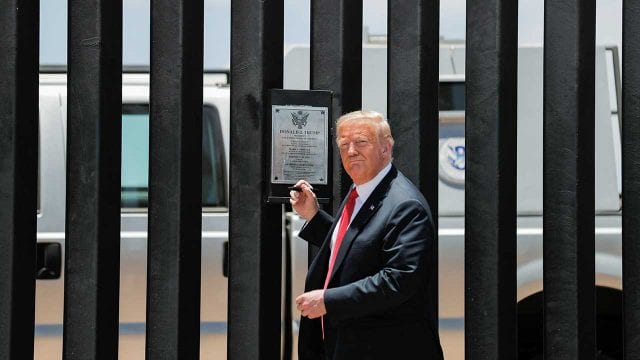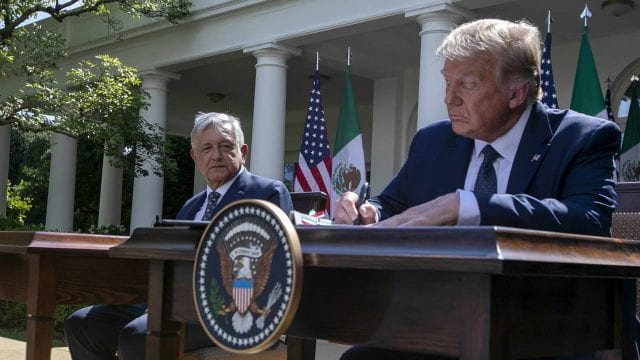Note published in Forbes México, in the Economía y Finanzas [Economy and Finance] Section, by Viridiana Mendoza Escamilla.
Read the note in its original source
The entry into force of the USMCA on July 1 was envisioned as a sign of less vulnerability for Mexico. Nevertheless, the new treaty does not appear to be an immediate fuel to boost the economy, on the contrary, it brings challenges that become even stronger in the environment of the Covid-19 pandemic.
“NAFTA has been a total disaster for the United States; it has taken away our manufacturing plants and our jobs. Never again. There will be consequences for the companies that abandon the United States. Under the Trump administration, no citizen will ever feel again that their needs come second to [those of] citizens of foreign countries. ”
The speech by Donald Trump made on April 27, 2016 as part of his presidential campaign marked the fate of the Mexican economy.
Between April and May of that year, the exchange rate went from 17.20 to 18.48 pesos to the dollar, and analyses on the outlook of the Mexican economy increasingly referred to the possibility of Trump seeking to dilute the North American Free Trade Agreement (NAFTA), terrible news, considering that 80% of Mexican exports go to the US market.
Four years (and multiple negotiations) later, on April 24, the Department of Economy announced that the new treaty, denominated USMCA (United States-Mexico-Canada Agreement) would enter into force; this time, however, the news did not have the same impact on the economy.
“We know it will enter into force. We do not expect an impact on the markets or on the country’s variables because it is a known factor”, said José Oriol, director of Grupo Bolsa Mexicana de Valores.

Donald Trump, President of the United States, is preparing to autograph a plaque commemorating the construction of the 200-mile border wall while visiting the wall on the United States-Mexico border in San Luis, Arizona, United States, on June 23, 2020. Photo: Carlos Barria / Reuters
In the opinion of Gabriela Siller, Director of Analysis at Banco Base, the USMCA is a factor that could aid the economy because uncertainty in regard to tariff rules decreases; nevertheless, this is not a factor to consider in the current scenario because the shortage of employment causes mistrust on investment, particularly in terms of foreign investment, which could trigger growth.
“Business confidence indicators have been below the threshold of 50 points during the year. The confidence of the business sector plummeted due to the impact of the pandemic on the economy. In May, the confidence indicator of the manufacturing sector fell to its lowest level since February 2009”, she explains.
RULES OF ORIGIN, A KEY TOPIC
The main differences between NAFTA and USMCA lie in the rules of origin of some sectors and in the changes in labor, environmental, digital commerce, agriculture and patent matters.
In 2019, commercial exchange between Mexico and the United States reached a record figure of 614,500 million dollars (MUSD), placing our country as one of the main commercial partners of the United States, with almost 15% of its total foreign trade. Gustavo López Montiel, professor at the School of Social Sciences and Government of the Tecnológico de Monterrey, explains that compliance with regulations on rules of origin will be a challenge.
Data from the Confederation of Industrial Chambers (Concamin) shows that 70% of the companies that manufacture export products for the United States could fail to comply with the rules of origin, which creates the necessity of negotiation to achieve compliance within a maximum term of three years. The options are to create a credible plan with annual goals or paying a 2.5% compensatory tariff.
It might be thought that this would be a good time to create national supplies, but even if new companies could be created, input materials are not produced in Mexico at competitive prices. Raw materials used in Mexico come from the United States and Asia.
Most imports into Mexico are input materials for manufacturing. This could be an area of opportunity, but it would depend on the type of materials that are required, since not all raw materials can be generated within the country.
LABOR IMPLICATIONS
One of the controversial topics during the negotiation was that of changes in labor matters. To the extent that the discussion of the agreement had an influence in the approval of the Labor Reform undertaken in Mexico.
The insertion of US inspection supervisors or entities in Mexican territory caused irritation among the business community. Gustavo López Montiel believes that the changes require the implementation of labor safety, salaries and training and union democracy verification mechanisms.
“Mexican unions and companies are not used to [being supervised]. Many of the new unions are protection or industrial unions. What is sought with the increase in wages and union democracy is clear: that the Mexican labor force loses competitiveness and that North American companies lose the incentive of cheap labor,” he explains.
Ricardo Martínez Rojas, founding partner of the De La Vega & Martínez Rojas Firm, explains that the treaty allows the filing of complaints between countries in case of a denial of labor rights, that is, for violation of the right of association or unionization of workers or for violations that affect effective collective bargaining.
“Before establishing a controversy panel, the country files a complaint. For example: if the complaint originates in Mexico, it must be made in regard to a company that exports to the United States or Canada with tariff benefits or to a company that produces a product or service that competes with another one in the other country”.
Complaints would be received by labor attachés at consulates and embassies, and may only be presented in regard to companies in priority industries: automotive, auto parts, mining, bakery, call centers and some other industries where products derived from cement and glass are generated.
“If the United States files a complaint, Mexico has an obligation to study it, investigate it and determine if it is valid. If the complaining country disagrees with the ruling, a panel with arbitrators from the [three] countries is created.
This panel can reinstate workers, but if actions are not complied with, penalizations for the company in question are activated; in the worst scenario, these penalizations include the possibility of the company losing its tariff rights ”.
The specialist believes that this section is dangerous, as it can be seen that it only implies a mechanism for complaints against Mexico. While Mexico can file complaints against the other two countries, the United States and Canada did not include this annex reciprocally. “If the complaint is filed by the United States, they are the ones that determine the ruling.
The reform is good because it seeks to bring order into unions. The negative part is that the US, from the very beginning, can request the limitation of tariff rights for Mexican Firms. That could be interpreted as our having surrendered sovereignty on labor regulation”, warns the labor lawyer.
LATENT THREATH.
Mexico and the United States experienced a moment of tension during the negotiation of the treaty when, in May 2019, Trump threatened with placing a 5% tariff on all merchandise if Mexico did not reduce “illegal immigration”.
The threat was withdrawn after the Mexican government deployed 6,000 elements of the National Guard on the southern border and contained the wave of migrant caravans, forcing Central American migrants to remain in the country.
Looking forward, even though Mexico, the United States and Canada have a legal scaffolding in commercial matters, our country cannot rule out new threats stemming from a change in Trump’s temperament or political platform
“This is a latent danger, although, in the first instance, the feeling is that the treaty generated more advantages for the United States and Canada”, pointed out Gustavo López Montiel.
Iliana Santibáñez, internationalist, professor and researcher at the Tecnológico de Monterrey, explains that, extra-officially, Mexico already has a responsibility for containing migratory flows from Central America.
“There are tariff and qualitative barriers. What will happen is that the treaty can stop exports with quotas or tariffs, but there will be non-tariff barriers. It cannot be said that new pressures will not come”, she warns.
I am text block. Click edit button to change this text. Lorem ipsum dolor sit amet, consectetur adipiscing elit. Ut elit tellus, luctus nec ullamcorper mattis, pulvinar dapibus leo.







